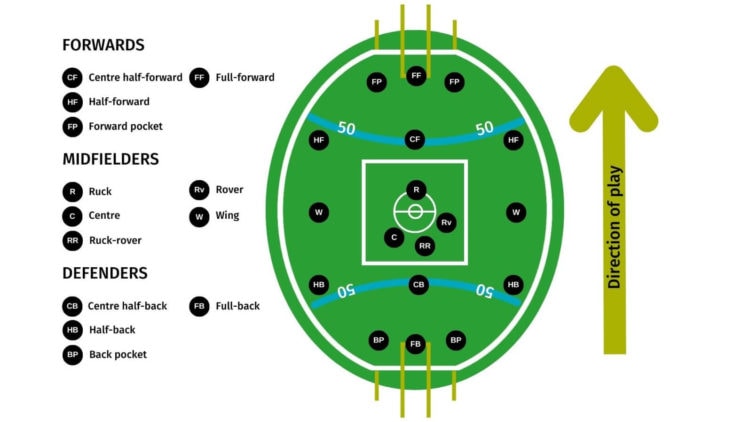
OBJECTIVE OF AUSTRALIAN FOOTBALL: Score more points than the opposing team by kicking the ball through the goalposts.
NUMBER OF PLAYERS: 36 players, 18 per team
MATERIALS: An Australian football, uniforms, mouthguard
TYPE OF GAME: Sport
AUDIENCE: 5+
OVERVIEW OF AUSTRALIAN FOOTBALL
Australian football (also known as “Aussie rules football”) is an action-packed sport that seemingly combines aspects of American football, rugby, soccer, and basketball. Commonly misconceived to be an Australian version of American football, Aussie rules football actually has a history that slightly precedes that of American football. However, both sports are ultimately based on soccer and rugby.
In the mid-1800s, Thomas Wentworth Willis, a prominent Australian cricket player, is credited with pioneering what would eventually become the sport of Australian football. It has long been debated where the sport’s influence came from, with many claiming Aussie rules football is a variation of Gaelic football, while others claim it may have been inspired by the Aboriginal game of “Marn Grook”. Despite all of these theories, rugby is generally known to be the main influence of the sport, as Willis himself attended a rugby school and participating in the rugby league growing up. In 1898 the sports national competition, which is known as the Grand final, was started.
Although Australian football is not played as an organized sport in any other country, it is the most popular sport in its native land, racking in an incredible $2.5 billion per year and reaching six-figure crowds for major events. Also noteworthy, the sport has developed an increasing popularity among women, with roughly a third of all registered players in the country being female.
SETUP

EQUIPMENT
Unlike American football, which requires extensive padding to play, Australian football simply requires a ball and mouthguard. The oval-shaped football used in Aussie rules is a slightly larger and rounder version of the football used in American football, although both balls are made of leather and feature the same iconic laces on top. An Australian football has a maximum circumference of 28.5 inches.
PLAYING SURFACE
While Australian football is compared to many different sports, the similarities stop once discussing the field. An Aussie rules football field is HUGE, measuring between 148 and 202 yards in length and 120 to 170 yards in width. Interestingly enough, the massive ranges in field size come from the fact that there are no official regulations regarding field dimensions other than the field being oval in shape. Australian football is often played on cricket grounds!
On each end of the oval field, four goalposts sit seven yards apart from each other. Players must kick the ball through these six-meter (19.69 feet) posts to score points. The inner two posts are worth six points, while the behind posts are worth one point.
PLAYER POSITIONS
An Australian football team consists of 18 players on the field at once, with four other players on the bench as substitutes that can enter the game at any time. Each player has a designated position, although these are only loose guidelines that indicate where a player should position themself on the field.
- Full Forwards: These players play as close to the other team’s goalposts as possible and are often responsible for scoring the most points. Full forward positions include: left forward pocket, full forward, and right forward pocket.
- Half Forwards: These players play primarily on the opponent’s side of the field, right behind the full forwards. Similarly, they’re also responsible for most scoring opportunities. Half forward positions include: left half-forward, center half-forward, and right half-forward.
- Center Line: These players are essentially midfielders contributing to offense and defense. Center line positions include: left wing, right wing, center, ruck, rover, and ruck-rover.
- Half Backs: These players are a team’s first line of defense. Half back positions include: left half back, center half back, and right half back.
- Full Backs: With no goalie in the sport, full backs are a team’s final line of defense. Players in this position include: left back pocket, full back, and right back pocket.
There are no offsides rules in Australian football; therefore, every position can move anywhere on the field at any given time.
GAMEPLAY

An Australian rules football match begins with what is known as a ruck; an umpire blows a whistle and bounces the ball high into the air, with one player from each team attempting to gain possession (similar to a jump ball in basketball).
From there, players run with the ball in their hands toward the opposing team’s goalposts. During this time, the ball carrier must dribble the ball off the ground a single time for every 16 yards they advance downfield. The ball carrier can also pass the ball in any direction to a teammate with their hands or feet, but the ball cannot be thrown. Instead, to pass the ball with their hands, a player must place the ball on their palm and “punch” it with a closed fist.
Defensive players are tasked with tackling the player with the ball and intercepting their passes in order to gain possession of the ball. Once a player is tackled, they must immediately dispose of the ball in a legal manner. If they are tackled to the ground with the ball in their possession, the player who tackled them is awarded a free kick. While defensive players attempt to tackle the ball carrier, offensive players can block and impede the defenders’ movements within five yards of the ball carrier.
The objective of both teams is to advance the ball downfield and kick the ball through any of the goalposts, particularly the higher-scoring middle posts. Upon scoring, play stops, and the teams position themselves for another midfield ruck.
GAME LENGTH
An Australian football match consists of four 20-minute quarters. Similar to soccer, extra time can be added to the clock for play stoppages (up to a maximum of 10 additional minutes). Teams must switch sides of the field at the end of each quarter.
MARKS
A “mark” is the term used to refer to when a player catches a teammate’s kicked pass from more than 16 yards away. The player who cleanly catches the pass is awarded the mark by the umpire, awarding them a free kick from anywhere behind the spot of the catch. During this time, players cannot attempt to tackle or block the kick unless the player with the ball decides to continue playing instead of taking the kick.
These marks are generally the highlight of the game, as they can result in spectacular catches that set a team up for high-percentage scoring opportunities.
SCORING
Points are scored anytime a player kicks a ball through or into any of the opponent’s four goalposts.
- 1 point is awarded to the attacking team for kicking a ball through the outer goalposts or for a kick that the ball hits any of the four goalposts.
- 6 points are awarded for kicking a ball through the middle two goalposts.
Upon scoring, the ball is brought back to the center of the field for an ensuing ruck.
Unlike American football, Australian football games often conclude with very high scores. Generally, a team will almost always score more than 60 points per game. However, top-tier teams can end up scoring in the triple-digits, with 2022’s Australian Football League (AFL) grand finals ending in a final score of 133–52!
Check out the highlights of this incredible match below:
Geelong Cats v Sydney Swans Highlights | 2022 Toyota AFL Grand Final | AFL
ADDITIONAL RULES AND CONTEXT
- Players can only tackle a player with the ball, which must be initiated between the shoulders and knees.
- A player doesn’t need to be tackled in order to give up the ball; holding the ball carrier is enough to force them to dispose of it.
- Players cannot be pushed in the back.
- Goal umpires can choose not to call a foul if it doesn’t help the benefitting team; this is similar to the soccer concept of “playing the advantage”.
- Although a player must dribble the ball every 16 yards, this distance isn’t strictly enforced, especially if a defender is contesting the player.
- play will be restarted upon an umpire’s call if the ball crosses the boundary line in its entirety.
END OF GAME
At the end of the fourth quarter, the team with the most points wins the match. If both teams are tied at the end of regulation, two five-minute overtime periods ensue, with teams switching sides after each.
- 30 GAMES TO PLAY OVER TEXT - April 22, 2024
- 20+ FREE PRINTABLE BABY SHOWER GAMES - April 16, 2024
- 20+ College Party Games for the Best Night Ever! - April 2, 2024